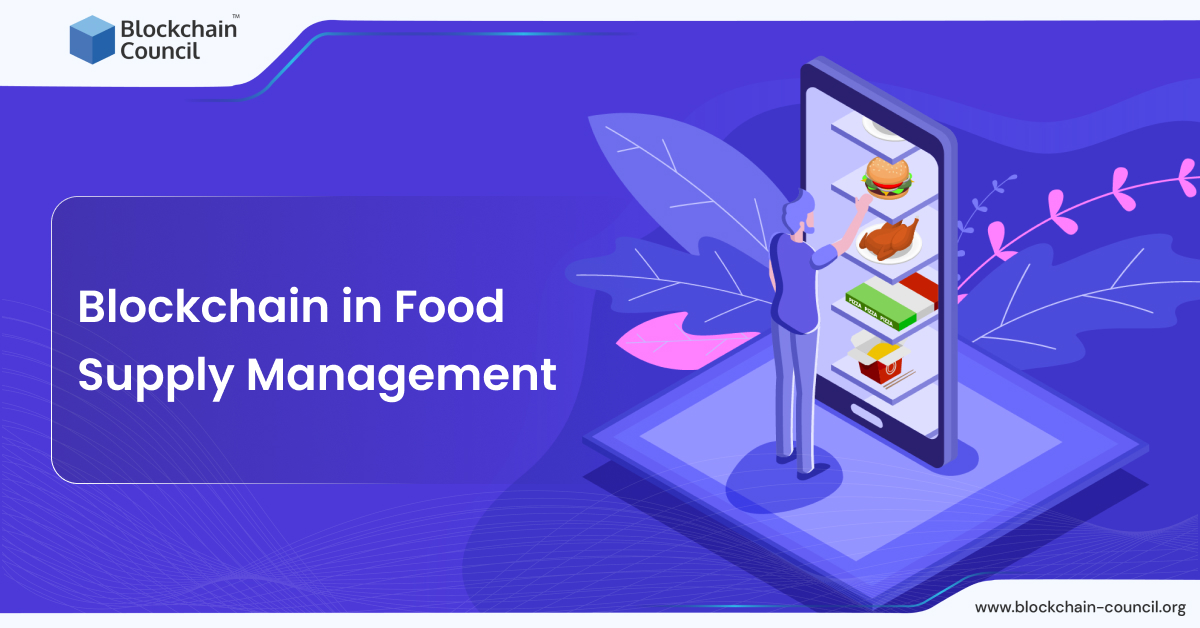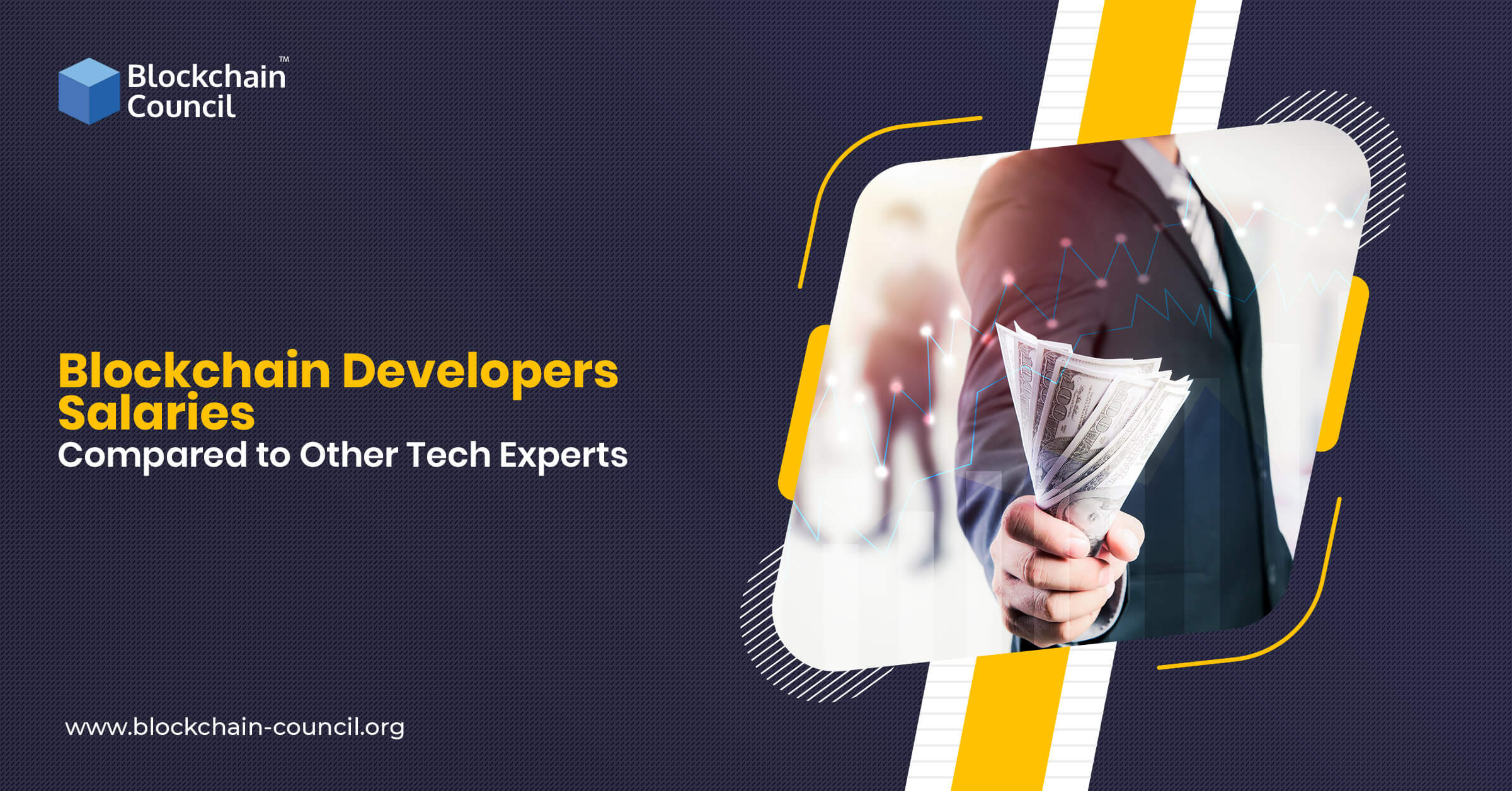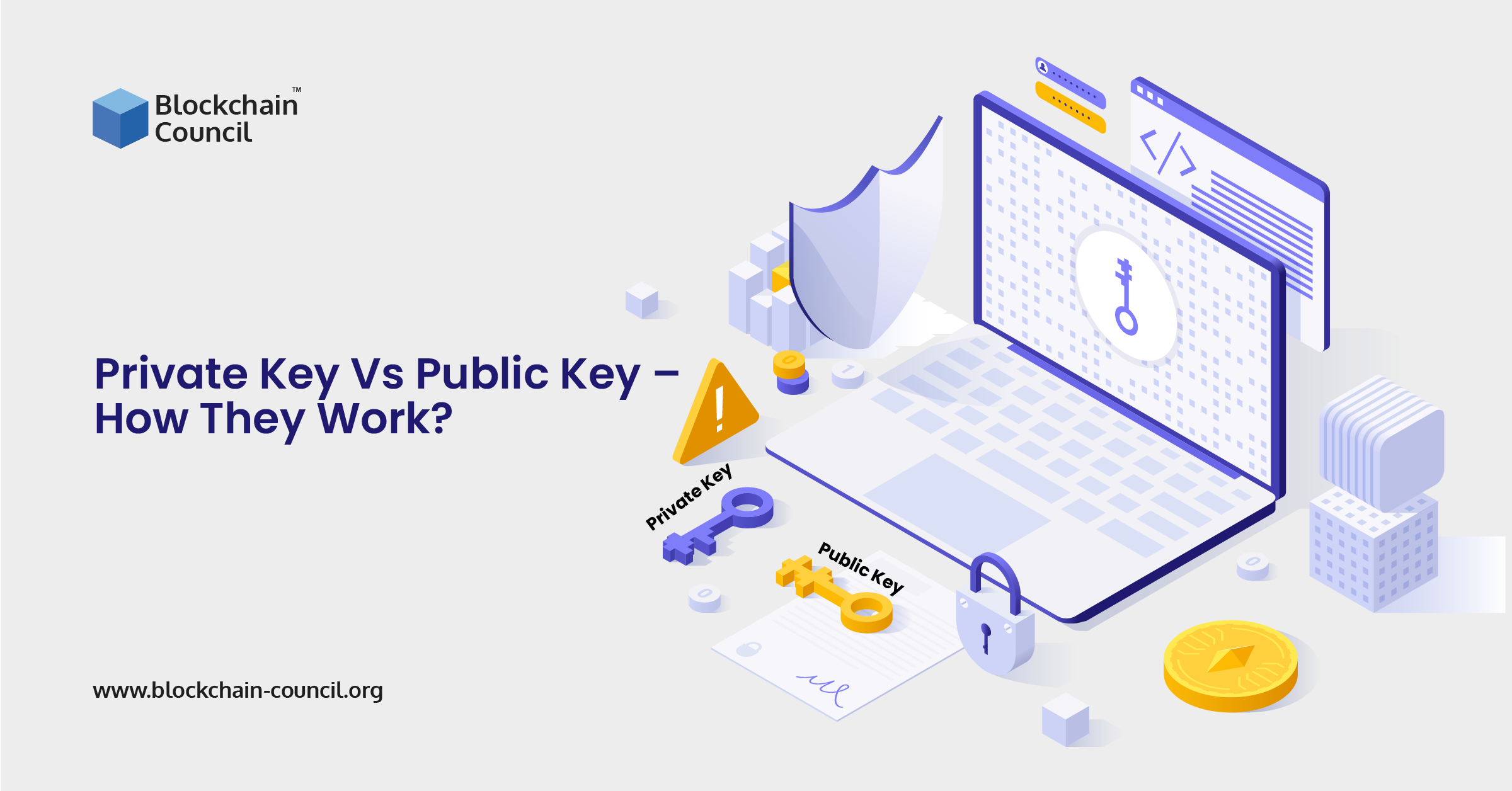
- Blockchain Council
- October 29, 2023
Summary
- Food supply management is crucial for ensuring the availability of safe and affordable food to a growing global population.
- Technology, including Blockchain, is reshaping the food supply management sector to make it more efficient and transparent.
- This article explains the role of Blockchain in food supply management.
- Blockchain is a digital ledger that records transactions securely and transparently, distributed across a network of computers.
- It operates on a decentralized model, where multiple participants collaborate to validate and record transactions.
- Blockchain’s key characteristics include transparency, security, and immutability, making it suitable for food supply management.
- Traceability issues and food safety concerns are significant challenges in the industry.
- Blockchain enables real-time monitoring and tracking of food products, enhancing traceability.
- It ensures the authenticity and quality of food products through immutable records and smart contracts.
- Blockchain can reduce food waste, manage allergen information, and verify organic and non-GMO claims.
- Adoption barriers include the need for education, cost considerations, and scalability to meet industry demands.
Food supply management is a critical aspect of our modern society, ensuring the availability of safe, nutritious, and affordable food to people worldwide. With the global population steadily increasing, the need for efficient and transparent food supply chains has become more pressing than ever. Technology has significantly reshaped various industries, and the food supply management sector is no exception. One of the revolutionary technologies that has gained traction in recent years is Blockchain. But what is Blockchain’s role in food supply management? Let’s find out!
Understanding the Importance of Food Supply Management
Before understanding the role of Blockchain in food supply management, the question arises, why should we care about food supply management? Effective food supply management is essential to prevent food shortages, minimize waste, and maintain food safety. A well-functioning supply chain ensures that food products are produced, processed, packaged, and distributed on time. It involves a complex network of farmers, producers, distributors, retailers, and consumers. Any disruption in this chain can lead to food scarcity or compromised safety, impacting both economies and public health.
The Role of Technology in Transforming the Industry
In the digital age, technology has been a driving force behind transformative changes in various industries. In the context of food supply management, technological advancements have helped streamline operations, enhance traceability, and ensure accountability. One technology that has emerged as a potential game-changer is Blockchain. Blockchain’s inherent transparency, security, and decentralization make it a compelling solution for tackling some of the challenges plaguing the food supply chain.
Also Read- 5 Must-Have AI Skills In 2024
Fundamentals of Blockchain Technology
Before diving into the role of Blockchain in the food industry let’s understand what Blockchain technology is.
Explaining Blockchain in Simple Terms
At its core, Blockchain is a digital ledger that records transactions in a way that is secure, transparent, and resistant to tampering. Imagine it as a chain of blocks, where each block contains a set of transactions. Once a block is filled with transactions, it is linked to the previous block, creating a chronological chain. This chain of blocks is distributed across a network of computers, ensuring that no single entity has complete control over the entire ledger.
How Does Blockchain Work?
| Steps | Explanation |
| Step 1 | Data Entry: Transactions are grouped together into a block. |
| Step 2 | Verification: The network of computers (nodes) checks the transactions for accuracy. |
| Step 3 | Consensus: Nodes must agree that the transactions are valid before adding the block to the chain. |
| Step 4 | Block Added: Once verified, the block is added to the Blockchain, forming a chain of blocks. |
| Step 5 | Immutability: The data in the block is secure and cannot be altered, ensuring trust and security. |
| Step 6 | Decentralization: The Blockchain is maintained by a decentralized network, eliminating the need for a central authority. |
Centralized systems rely on a single authority to maintain records and verify transactions. In contrast, Blockchain operates on a decentralized model, where multiple participants (nodes) in the network collaborate to validate and record transactions. When a new transaction is initiated, it must be verified by a consensus mechanism among the nodes before it is added to the ledger. This consensus mechanism ensures the accuracy and integrity of the information recorded on the Blockchain.
Key Characteristics of Blockchain
Transparency: Transparency is a hallmark of Blockchain technology. All participants in the network can view the same version of the ledger, reducing the possibility of fraudulent activities. Once a transaction is recorded on the Blockchain, altering it becomes nearly impossible. This immutability is achieved through cryptographic hashing, which creates a unique fingerprint for each block. If a change is attempted in a previous block, it would require the alteration of all subsequent blocks, a task computationally infeasible and easily detectable.
Security: Security is paramount in the food supply management sector, given the potential risks associated with contaminated or counterfeit products. Blockchain’s architecture enhances security by providing encryption and authentication mechanisms. Each participant in the network has a cryptographic key that grants access to their transactions. This ensures that only authorized individuals can participate in the network and validate transactions.
Immutability: Immutability is a key characteristic of Blockchain technology. Once a transaction is recorded on the Blockchain, it’s extremely hard to change. This is because of cryptographic hashing, which creates a unique fingerprint for each block. If someone tries to alter a previous block, they’d have to change all the following blocks, which is practically impossible and easy to spot.
Current Challenges in Food Supply Management
Traceability Issues
Traceability is a significant challenge in the food supply management industry. The journey of food products from their origin on farms to the consumer’s table involves numerous intermediaries and complex processes. However, it’s often difficult to accurately trace a product’s entire path. This lack of transparency can lead to inefficiencies, delays, and difficulties in pinpointing the source of contamination or other issues. Consumers increasingly demand to know where their food comes from and how it was produced, which necessitates improved traceability solutions.
Food Safety Concerns
Food safety is a critical concern that directly impacts public health. Contamination incidents, such as outbreaks of foodborne illnesses, can have severe consequences. When contamination occurs, it’s essential to quickly identify the source and scope of the issue to prevent further spread. Traditional methods of tracing the origin of contaminated products are often slow and inefficient, delaying response efforts and potentially putting more people at risk. The ability to rapidly trace back contaminated products can significantly mitigate the impact of such incidents.
Lack of Trust
The complexity of modern food supply chains has led to a lack of trust between various stakeholders, including producers, distributors, retailers, and consumers. Information about food products’ origin, production methods, and handling can be withheld or misrepresented, creating information asymmetry. This lack of transparency erodes trust throughout the supply chain and can lead to fraudulent practices. A reliable and transparent system is needed to build and maintain trust to ensure that information is accessible, accurate, and tamper-proof.
Also Read- Top 5 Artificial Intelligence Trends In 2024
Blockchain Applications in Food Supply Management
Enhanced Traceability: Real-time Monitoring and Tracking
Blockchain technology offers a solution to the traceability challenge by enabling real-time monitoring and tracking of food products at every stage of the supply chain. Each transaction and movement can be recorded on the Blockchain, creating an immutable and transparent record of the product’s journey. This level of transparency helps identify the origin of any issues and provides consumers with accurate information about the product’s source, processing, and transportation.
Immutable Records: Ensuring Food Authenticity and Quality
Blockchain’s immutable nature ensures that once data is recorded, it cannot be altered or deleted without leaving a trace. This feature is particularly valuable in ensuring the authenticity and quality of food products. Certifications, inspections, and quality control measures can be recorded on the Blockchain, providing a reliable record of the product’s compliance with various standards. This information is accessible to all stakeholders, fostering trust and reducing the risk of fraudulent practices.
Smart Contracts: Automating Transactions and Compliance
Smart contracts are self-executing agreements with predefined conditions. In the context of food supply management, smart contracts can automate various processes, such as payments, certifications, and compliance checks. For example, when a shipment of perishable goods reaches a certain temperature threshold, a smart contract can automatically trigger a payment or a notification to relevant parties. This automation not only reduces administrative overhead but also ensures that contractual obligations are met without manual intervention.
Also Read- Why AI Is Important For The Metaverse
Advantages of Blockchain in the Food Industry
Blockchain technology has emerged as a revolutionary tool in the realm of food supply management. Its decentralized and transparent nature offers several key advantages that address longstanding challenges within the food industry. This section will explore three significant benefits of integrating Blockchain into the food supply chain.
Transparency: Empowering Consumers with Information
One of the most compelling advantages of Blockchain technology is its ability to provide unprecedented transparency throughout the entire food supply chain. Traditionally, consumers have been left in the dark about their food products’ origin, journey, and handling. This lack of information has led to concerns about food safety, ethical sourcing, and environmental impact.
Blockchain tackles this issue by creating an immutable and tamper-proof ledger of every transaction and interaction involving a food product. Each step, from farm to fork, is recorded on the Blockchain, and this information is accessible to all relevant parties, including consumers. As a result, consumers can use their smartphones to scan QR codes on products and gain instant access to a wealth of data, such as the farm where the product originated, the dates and locations of processing and transportation, and any quality control tests conducted along the way. This newfound transparency empowers consumers to make informed choices aligned with their values, whether it’s supporting local farmers or avoiding allergens.
Efficiency: Streamlining Supply Chain Operations
The food supply chain is notorious for its complexity, involving multiple intermediaries, extensive paperwork, and varying regulations. This complexity often leads to inefficiencies, delays, and even food waste. Blockchain’s decentralized and automated nature has the potential to streamline these operations significantly.
By digitizing the supply chain on a Blockchain, all participants, from farmers and suppliers to distributors and retailers, share a single source of truth. Smart contracts, self-executing code stored on the Blockchain, can automate various tasks and trigger actions based on predefined conditions. For instance, when a shipment of perishable goods reaches a certain temperature threshold, the Blockchain can automatically alert relevant parties, preventing spoilage and minimizing losses. Such automation reduces the need for manual intervention and accelerates the entire supply chain process, ensuring fresher products on the shelves and less waste overall.
Reduced Fraud: Preventing Counterfeit Products
Counterfeit and adulterated food products significantly risk consumer health and brand reputation. Blockchain technology’s decentralized and tamper-proof nature offers a robust solution to combat such fraudulent activities.
Whenever a product changes hands in the supply chain, a new block containing a transaction record is added to the Blockchain. These blocks are linked chronologically, creating an unbroken chain of custody. As a result, any attempt to alter information about a product’s origin or journey would require the consensus of the entire network—a virtually impossible feat. This immutability makes it exceedingly difficult for bad actors to introduce counterfeit goods into the supply chain unnoticed.
Additionally, Blockchain can enable real-time tracking of products, allowing retailers and consumers to verify the authenticity of a product using its unique Blockchain-issued identifier. This verification process ensures that the product they purchase is genuine and meets quality standards.
Real-world Examples of Blockchain Adoption in Food Supply Management
Several pioneering companies have already harnessed the power of Blockchain to transform food supply management. These real-world examples showcase the tangible impact of Blockchain technology on enhancing traceability, safety, and sustainability in the food industry.
IBM Food Trust: Revolutionizing Food Traceability
IBM Food Trust is a prime illustration of how Blockchain can revolutionize food traceability. Collaborating with major players in the industry, including Walmart and Nestle, IBM developed a Blockchain-based platform that enables end-to-end visibility into the food supply chain. By digitizing and sharing food origin, processing, and distribution data, IBM Food Trust empowers consumers to make informed choices. It helps companies identify the source of contamination in case of outbreaks or recalls.
Walmart’s Blockchain Initiative: Ensuring Product Safety
Retail giant Walmart has taken bold steps to ensure product safety and traceability by implementing Blockchain technology. In partnership with IBM, Walmart launched a pilot project to trace the journey of mangoes from farm to store shelf. The results were remarkable: what previously took days to trace back to its source could now be achieved in mere seconds, thanks to Blockchain’s transparent ledger. This enhances food safety and minimizes recalls’ economic impact by swiftly identifying affected batches.
Fishcoin: Empowering Small-Scale Fishermen
Fishcoin demonstrates the potential of Blockchain to address social and environmental challenges in the seafood industry. This initiative aims to empower small-scale fishermen in Southeast Asia by providing them with smartphones equipped with Blockchain technology. When a fisherman catches a fish, the details are recorded on the Blockchain, creating an indelible record of the catch. This data can then be shared with buyers, ensuring fair pricing and preventing fish fraud. Furthermore, Fishcoin’s Blockchain-based system incentivizes sustainable fishing practices by rewarding fishermen who adhere to responsible fishing standards.
Implementing Blockchain: Challenges and Considerations
Blockchain technology has gained significant attention for its potential to revolutionize various industries, and the food supply chain management sector is no exception. However, implementing Blockchain in food supply management comes with its own challenges and considerations. This section delves into the key hurdles that must be overcome for successful adoption.
- Integration with Existing Systems: Technical Hurdles Integrating Blockchain into existing supply chain systems can be complex. Many food supply management systems are built on legacy technologies that lack compatibility with Blockchain. Migrating data and processes to a Blockchain-based system requires careful planning and coordination. The challenge lies in ensuring a smooth transition without disrupting day-to-day operations. Companies must invest in skilled IT professionals and resources to ensure a seamless integration.
- Data Privacy and Security: Protecting Sensitive Information Blockchain’s decentralized and immutable nature can enhance data security, but it also raises concerns about data privacy. While transactions are secure and transparent, ensuring that sensitive business information remains confidential is crucial. Striking the right balance between transparency and privacy is essential. Additionally, the use of public and private Blockchain networks must be evaluated based on the nature of the data being stored and shared.
- Collaborative Ecosystem: Getting Stakeholders on Board The effectiveness of Blockchain in food supply management relies on collaboration among various stakeholders, including farmers, suppliers, distributors, retailers, and regulators. Convincing all parties to adopt a Blockchain-based system requires education about the technology’s benefits and a clear demonstration of its value. Resistance to change and concerns about data sharing may hinder adoption. Establishing industry-wide standards and protocols can help build trust and facilitate participation.
Regulatory and Legal Implications
As Blockchain technology disrupts traditional food supply management practices, it brings forth regulatory and legal implications that must be carefully navigated to ensure compliance and mitigate risks.
- Compliance with Food Safety Regulations: Compliance with Food Safety Regulations Ensuring food safety is a top priority in the supply chain. Blockchain’s ability to provide real-time traceability can aid in quickly identifying and containing outbreaks of foodborne illnesses. However, meeting regulatory requirements, such as the FDA’s Food Safety Modernization Act (FSMA), while implementing Blockchain can be challenging. Industry players must collaborate to align Blockchain solutions with existing regulations to ensure that safety standards are not compromised.
- Data Ownership and Sharing: Navigating Legal Complexities Blockchain operates on a distributed ledger, raising questions about data ownership and control. Determining who owns the data stored on the Blockchain and how it can be accessed and used requires legal clarity. Smart contracts, which automate and enforce predefined terms, must be carefully drafted to ensure they align with contractual and legal obligations. Establishing a framework for data ownership and sharing is crucial to avoid disputes.
- International Trade: Addressing Cross-border Challenges The global nature of the food supply chain involves cross-border trade and compliance with diverse international regulations. Blockchain’s potential to enhance transparency and streamline cross-border transactions is promising. However, differing legal frameworks and trade agreements must be considered. Harmonizing Blockchain implementations with international trade laws is essential to prevent delays and disputes at customs checkpoints.
Future Potential and Trends
Blockchain technology has garnered significant attention in recent years due to its potential to revolutionize various industries, and the food supply management sector is no exception. As we look toward the future, several key trends are emerging that highlight how Blockchain can reshape the landscape of food supply management.
IoT Integration: Creating a Seamless Data Network
Integrating the Internet of Things (IoT) with Blockchain technology is poised to bring about a new era of transparency and efficiency in food supply chains. IoT devices such as sensors, RFID tags, and GPS trackers can collect real-time data at every step of the supply chain journey. This data can then be securely recorded on the Blockchain, creating an immutable record of the product’s journey from farm to fork. This integration enables stakeholders to track perishable goods’ temperature, humidity, and location, ensuring that they adhere to optimal storage conditions. Automated alerts can be triggered in case of any deviations, preventing potential spoilage and maintaining product quality. This synergy between IoT and Blockchain bolsters traceability, reduces losses, and ultimately enhances consumer trust.
Supply Chain Optimization: Predictive Analytics and AI
Blockchain’s decentralized nature and predictive analytics and artificial intelligence (AI) offer remarkable potential for optimizing supply chains. By analyzing historical data recorded on the Blockchain, AI algorithms can predict demand patterns, identify potential disruptions, and recommend proactive solutions. This proactive approach minimizes the impact of unforeseen events, such as weather-related delays or transportation issues. Moreover, AI-powered smart contracts can automate various supply chain processes, such as order fulfillment and payment settlements, reducing the need for intermediaries and streamlining operations.
Sustainability and Fair Trade: Empowering Ethical Practices
Consumers are increasingly concerned about their food choices’ environmental and ethical implications. Blockchain technology can be pivotal in promoting sustainability and fair trade practices within the food supply chain. Through Blockchain-enabled platforms, consumers can access detailed information about the origin of their food products, including the methods of production, transportation, and labor practices involved. This transparency empowers consumers to make informed decisions aligned with their values. Additionally, Blockchain’s ability to verify the authenticity of certifications (e.g., organic, fair trade) ensures that claims made by producers are legitimate, reducing the risk of greenwashing and enhancing the credibility of ethical products.
Blockchain’s Impact on Food Quality
| Impact Area | Explanation |
| Reducing Food Waste | Blockchain’s real-time tracking helps monitor conditions and prevents spoilage, resulting in fresher products and reduced food waste. |
| Allergen Management | Blockchain records allergen information for personalized access, enhancing safety for individuals with allergies. |
| Organic & GMO Verification | Blockchain ensures transparency in verifying organic and non-GMO claims, building consumer confidence in food products. |
Reducing Food Waste: Fresher Products and Timely Distribution
Food waste is a critical issue that not only affects economies but also exacerbates global food insecurity. Blockchain’s real-time tracking capabilities can contribute significantly to reducing food waste. Through a case study involving a perishable goods supply chain, the implementation of Blockchain allowed stakeholders to monitor temperature, humidity, and transportation conditions in real-time. In instances where deviations occurred, swift interventions were made to prevent spoilage. This resulted in fresher products reaching consumers and substantially reduced food waste along the supply chain.
Allergen Management: Personalized Food Information
For individuals with food allergies, accurate allergen information is a matter of health and safety. Blockchain technology can facilitate the management of allergen-related data. In a case study involving a restaurant chain, each ingredient’s information was recorded on the Blockchain, including allergen details. Customers could access this information by scanning a QR code on the menu with their smartphones. This personalized approach ensured that individuals received accurate allergen information tailored to their specific dietary needs, enhancing their dining experience while minimizing health risks.
Organic and GMO Verification: Building Consumer Confidence
Verifying the authenticity of organic and non-GMO (genetically modified organisms) claims has been challenging in the food industry. Blockchain’s immutable ledger offers a solution. In a case study focusing on organic produce, each step of the production process, from planting to harvesting, was recorded on the Blockchain. This enabled consumers to trace the origin of the produce and verify its organic status independently. Additionally, Blockchain’s transparency countered the skepticism surrounding genetically modified foods. The recorded data assured that the products were indeed free from genetically modified ingredients.
Overcoming Adoption Barriers
Blockchain in Food Supply Management
Blockchain technology has been making waves across various industries, and the food supply management sector is no exception. However, despite its potential to revolutionize how food is tracked and managed throughout the supply chain, several adoption barriers must be addressed. In this section, we’ll delve into the key challenges that need to be overcome to successfully integrate Blockchain technology in the food supply management industry.
Education and Awareness: Understanding Blockchain’s Benefits
One of the primary hurdles to Blockchain adoption in food supply management is a lack of understanding of the technology itself and its potential benefits. Many stakeholders in the industry might be familiar with Blockchain only in the context of cryptocurrencies, such as Bitcoin. However, Blockchain offers much more than that. It provides a transparent and immutable ledger that can be used to track every step of a food product’s journey from farm to table.
To overcome this barrier, it’s crucial to educate all stakeholders about the specific advantages of Blockchain in food supply management. This includes explaining how Blockchain ensures data integrity, enhances traceability, and minimizes fraud. The industry can bridge the knowledge gap through workshops, seminars, and easy-to-understand informational materials and help decision-makers make informed choices about adopting Blockchain solutions.
Cost Considerations: Balancing Investment and ROI
Implementing Blockchain technology requires an investment in terms of both time and resources. This investment can be a significant barrier, especially for smaller players in the food supply management industry. The perceived high initial costs might deter businesses from exploring Blockchain solutions, even though the long-term benefits can outweigh these costs.
To address this concern, stakeholders must analyze Blockchain technology’s potential return on investment (ROI). This involves evaluating how Blockchain can streamline operations, reduce inefficiencies, and cut down on costs related to fraud and recalls. Additionally, exploring cost-sharing models within industry collaborations can help distribute the financial burden more evenly.
Scalability: Meeting the Demands of a Growing Industry
The food supply management industry is expansive and constantly growing to meet global demands. Blockchain solutions must be scalable to accommodate the increasing volume of data generated across the supply chain. Traditional Blockchain networks, like those used for cryptocurrencies, have faced challenges with scalability when dealing with large numbers of transactions.
The industry can explore various Blockchain platforms that offer scalability solutions to overcome this barrier. Some platforms use side chains or sharding to distribute the load and ensure that the network can handle a high volume of transactions without compromising speed or security. By selecting the right Blockchain infrastructure, the food supply management sector can ensure that its technology can grow alongside the industry’s demands.
Conclusion
Blockchain technology can potentially revolutionize the food supply management industry by addressing longstanding challenges related to transparency, traceability, and data integrity. However, successfully adopting Blockchain in this sector requires overcoming several key barriers. Through education and awareness initiatives, stakeholders can ensure that decision-makers understand the specific benefits of Blockchain and how it can enhance the entire supply chain.
The role of Blockchain in food supply management is crucial. While the initial investment in Blockchain implementation might seem daunting, it’s essential to consider the long-term return on investment. Blockchain solutions can ultimately lead to cost savings and increased efficiency by streamlining operations, reducing fraud, and improving traceability. Exploring collaborative models and sharing costs within industry partnerships can help alleviate the financial burden for individual players.
FAQs
How can Blockchain reduce food waste?
- Blockchain can reduce food waste by offering real-time tracking capabilities that monitor the conditions during the transportation of food products.
- This helps prevent spoilage and ensures fresher products reach consumers.
- It enables swift interventions when deviations in temperature or humidity occur, minimizing the risk of food going to waste due to improper storage or handling.
- By providing accurate and transparent information about a product’s journey, Blockchain reduces inefficiencies, delays, and food waste along the entire supply chain.
What are the benefits of Blockchain for food traceability?
- Blockchain offers several benefits for food traceability, including real-time monitoring and tracking of food products at every stage of the supply chain.
- This creates an immutable and transparent record of the product’s journey, making it easier to trace the origin of issues like contamination.
- Blockchain empowers consumers by providing them with accurate information about a product’s source, processing, and transportation.
- This enables consumers to make informed choices about their food, enhancing transparency in the industry.
How does Blockchain benefit food security?
- Blockchain benefits food security through its transparency and traceability features, making it easier to pinpoint the source of contaminated food products.
- This allows for quick containment of outbreaks and prevents further harm to consumers.
- It ensures the authenticity and quality of food products by recording certifications, inspections, and quality control measures on the Blockchain.
- This reduces the risk of fraudulent practices and ensures that consumers receive genuine and safe products.
- Blockchain’s immutability and tamper-proof nature enhance the security of food supply chains by preventing unauthorized access and ensuring that only authorized individuals can participate in the network.
What is the role of Blockchain in food supply management?
- Blockchain plays a pivotal role in food supply management by enhancing transparency and traceability in the entire supply chain.
- It accomplishes this by recording every transaction and interaction involving food products on a secure and transparent digital ledger.
- The technology streamlines operations by reducing inefficiencies and automating processes through the use of smart contracts.
- It also ensures compliance with standards and regulations, helping to maintain food safety and quality.
- Blockchain empowers consumers by providing access to detailed information about their food, from its origin to handling practices.



































































 Guides
Guides News
News Blockchain
Blockchain Cryptocurrency
& Digital Assets
Cryptocurrency
& Digital Assets Web3
Web3 Metaverse & NFTs
Metaverse & NFTs
